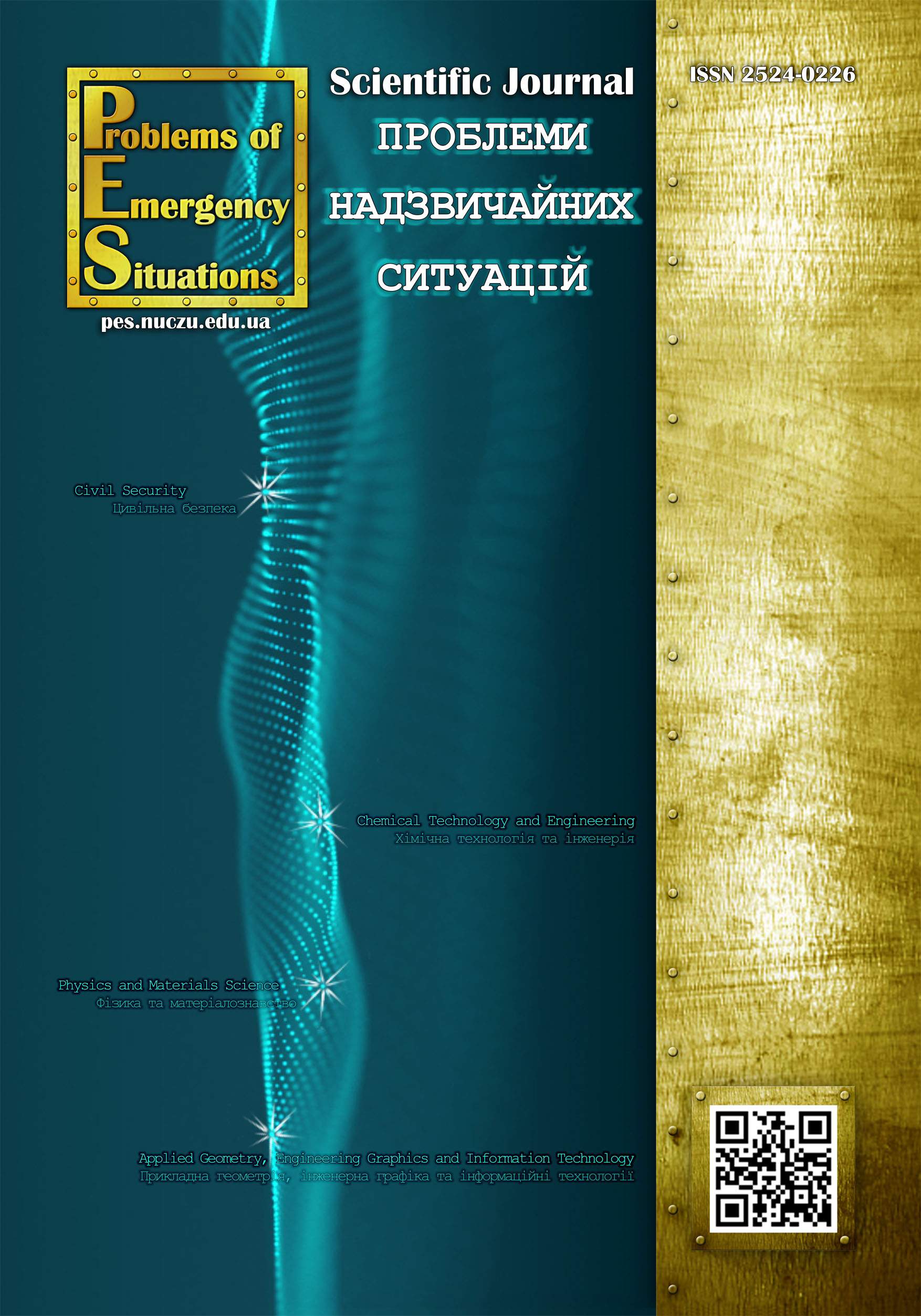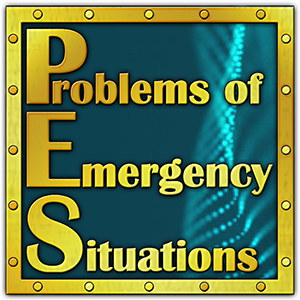Selection of the most effective means of extinguishing flammable liquids.
Kireev Oleksandr
National University of Civil Protection of Ukraine
https://orcid.org/0000-0002-8819-3999
Hapon Yuliana
National University of Civil Protection of Ukraine
http://orcid.org/0000-0002-3304-5657
Chyrkina-Kharlamova Maryna
National University of Civil Protection of Ukraine
https://orcid.org/0000-0002-2060-9142
Slepuzhnikov Yevhen
National University of Civil Protection of Ukraine
https://orcid.org/0000-0002-5449-3512
Cherkashyn Oleksandr
National University of Civil Protection of Ukraine
https://orcid.org/0000-0003-3383-7803
DOI: https://doi.org/10.52363/2524-0226-2024-40-3
Keywords: fire extinguishing efficiency, gel-forming flammable liquids, economic parameters, quick-setting foam system, bulk materials
Аnnotation
The paper compares the effectiveness of existing and new means of extinguishing tanks with a fixed roof containing flammable liquids. Flammable liquids are considered as combustible liquids. It is substantiated that high fire extinguishing characteristics when extinguishing flammable substances can be provided by means in which the dominant mechanism of combustion termination is the isolation of the liquid surface from the combustion zone. Currently, worldwide regulatory documents require the use of air-mechanical foams as the main means of extinguishing liquids. But they have a number of disadvantages. One of them is the low resistance of the foam to the heat flow from the flame of the burning liquid. As an alternative to air-mechanical foams, it is proposed to consider the recently developed fast-curing foams, as well as foam-glass + gel, foam-glass + bulk material, and foam-glass + bulk material + water systems. To compare the properties of new fire extinguishing systems and air-mechanical foams, it is proposed to use a quantitative complex parameter of the effectiveness of fire extinguishing agents. This parameter takes into account the financial costs of: fire extinguishing agents, their storage, processing or disposal after the expiration of their storage period; equipment and its operation; involvement of additional equipment and personnel, compensation for losses from the extinguishing process; compensation for environmental damage from fire extinguishing agents. In general, the comprehensive efficiency parameter is calculated as the sum of the seven selected financial components. At the first stage, it is proposed to use a simplified scoring option for calculating the complex economic parameter of efficiency. To do this, the components of efficiency are determined by the method of expert assessments. The highest value of the complex efficiency parameter was shown by two fire extinguishing systems: foam glass + bulk material and foam glass + bulk material + water. For these systems, it is proposed to conduct appropriate experimental studies on model fires of large size.
References
- Hylton, J. G., Stein, G. P. U.S. (2017). Fire Department Profile. National Fire Protection Association. Available at: https://www.nfpa.org/-/media/Files/News-and-Research/Fire-statistics/Fire-service/osfdprofile.pdf
- EN 1568-1:2018. Fire extinguishing media – Foam concentrates – Part 1: Specification for medium expansion foam concentrates for surface application to water-immiscible liquids. European committee for standardization, 2018, 44. Available at: https://standards.iteh.ai/catalog/standards/cen/29188adf-ed7b-49cf-9e76-b996ab64fd89/en-1568-1-2018
- EN 1568-2:2018. Fire extinguishing media – Foam concentrates – Part 2: Specification for high expansion foam concentrates for surface application to water-immiscible liquids. European committee for standardization, 2018, 41. Available at: https://standards.iteh.ai/catalog/standards/cen/1b7c7790-8464-4bc4-9ec6-b98ac41ff5ed/en-1568-2-2018
- EN 1568-3:2018. Fire extinguishing media – Foam concentrates – Part 3: Specification for low expansion foam concentrates for surface application to water-immiscible. European committee for standardization, 2018, 59. Available at: https://standards.iteh.ai/catalog/standards/cen/6e79e77f-10b9-4be3-b589-23797d03ae3b/en-1568-3-2018
- EN 1568-4. Fire extinguishing media – Foam concentrates – Part 4: Specifica-tion for low expansion foam concentrates for surface application to water-miscible liquids. European committee for standardization, 2018, 55. Available at: https://standards.iteh.ai/catalog/standards/cen/333cc3e6-35bc-4525-9e86-7c51a8be409f/en-1568-4-2018
- DSTU EN 2:2014 Klasyfikatsiia pozhezh (EN 2:1992; EN 2:1992/A1:2004, IDT). Available at: https://online.budstandart.com/ua/catalog/doc-page?id_doc=63091
- Dadashov, I., Loboichenko, V., Kireev, A. (2018). Analysis of the ecological characteristics of environment friendly fire fighting chemicals used in extinguishing oil products. Pollution Research, 37, 1, 63–77. Available at: http://29yjmo6.257.cz/bitstream/123456789/9380/1/Poll%20Res-10_proof.pdf
- Pietukhov, R., Kireev, А., Tregubov, D., Hovalenkov, S. (2021). Experimental Study of the Insulating Properties of a Lightweight Material Based on Fast-Hardening Highly Resistant Foams in Relation to Vapors of Toxic Organic Fluids. Materials Sci-ence Forum, 1038, 374–382. doi: 10.4028/www.scientific.net/msf.1038.374
- Musayev, M., Dadashov, I. (2021). Development of a single means for preventing the evaporation of toxic liquids and extinguishing class B fires. Academy of the Ministry of Emergencies of the Republic of Azerbaijan, 3–4, 117–124. Available at: https://engineeringmechanics.az/uploads/2023/05/8-fhn-akademiya-musayev-meqale-03-11-2021.pdf
- Mahammad, E. Musayev, Ilgar F. Dadashov, Alexander A. Kireev, Rza Kh.Khudiyev. (2024). Research fire extinguishing and insulating characteristics of fast-hardening foams. Processes of Petrochemistry and Oil Refining, 25, 2, 567–577. doi: 10.62972/1726-4685.2024.2567
- Dubinin, D., Korytchenko, K., Lisnyak, A., Hrytsyna, I., Trigub, V. (2017). Numerical simulation of the creation of a fire fighting barrier using an explosion of a combustible charge. Eastern-European Journal of Enterprise Technologies, 6(10(90)), 11–16. doi: 10.15587/1729-4061.2017.114504
- Semko, A., Rusanova, O., Kazak, O., Beskrovnaya, M., Vinogradov, S., Gricina, I. (2015). The use of pulsed high-speed liquid jet for putting out gas blow-out. The International Journal of Multiphysics, 9(1), 9–20. doi: 10.1260/1750-9548.9.1.9/
- Dubinin, D., Korytchenko, K., Lisnyak, A., Hrytsyna, I., Trigub, V. (2018). Improving the installation for fire extinguishing with finely dispersed water Eastern European Journal of Enterprise Technologies, 2, 10–92, 38–43. doi: 10.15587/1729-4061.2018.127865/
- Vambol, S., Bogdanov, I., Vambol, V., Suchikova, Y., Kondratenko, O., Hurenko, O., Onishchenko, S. Research into regularities of pore formation on the sur-face of semiconductors. (2017). Eastern-European Journal of Enterprise Technologies, 3, 5–87, 37–44. doi: 10.15587/1729-4061.2017.104039
- Chernukha, A., Teslenko, A., Kovalov, P., Bezuglov, O. (2020). Mathematical Modeling of Fire-Proof Efficiency of Coatings Based on Silicate Composition. Materi-als Science Forum, 1006, 70–75. doi: 10.4028/www.scientific.net/msf.1006.70
- Vasilchenko, A., Otrosh, Y., Adamenko, N., Doronin, E., Kovalov, A. (2018). Feature of fire resistance calculation of steel structures with intumescent coating. MATEC Web of Conferences, 230, 02036. doi: 10.1051/matecconf/201823002036
- Kustov, M., Kalugin, V., Tutunik, V., Tarakhno, O. (2019). Physicochemical principles of the technology of modified pyrotechnic compositions to reduce the chemical pollution of the atmosphere. Voprosy Khimii i Khimicheskoi Tekhnologii, (1), 92–99. doi: 10.32434/0321-4095-2019-122-1-92-99
- Dadashov, I., Kirieiev, O., Trehubov, D., Tarakhno, O. (2021). Hasinnia horiuchykh ridyn tverdymy porystymy materialamy ta heleutvoriuiuchymy systemamy. Kharkiv, 240. Available at: http://repositsc.nuczu.edu.ua/handle/123456789/14033
- Makarenko, V., Kireev, А., Slepuzhnikov, Y., Hovalenkov, S. (2023). Proper-ties of multi-component fire extinguishing systems based on light bulk materials. Key Engineering Materials, 954, 177–184. doi: 10.4028/p-6v6dmx
- Makarenko, V., Kirieiev, O., Chyrkina-Kharlamova, M., Minska, N., Sharshanov, A. (2023). Doslidzhennia hasinnia modelnoho vohnyshcha pozhezhi klasu «V» sypkymy materialamy. Problemy nadzvychainykh sytuatsii, 2(38), 281–296. doi: 10.52363/2524-0226-2023-38-19
- Trehubov, D., Dadashov, I., Minska, N., Hapon, Yu., Chyrkina-Kharlamova, M. (2024). Fizyko-khimichni osnovy rozvitku ta hasinnia pozhezh horiuchykh ridyn. Kharkiv: FOP Panov A. M., 216. ІSBN 978-617-8113-75-9. Available at: http://repositsc.nuczu.edu.ua/bitstream/123456789/19111/3/%d0%a4%
d0%a5%d0%9e%d0%9f%d0%a0%d0%bf%d1%80%d0%b5%d0%bf%d1%80%d1%96%d0%bd%d1%82.pdf
- Makarenko, V., Kirieiev, O., Chyrkina-Kharlamova, M., Slepuzhnikov, Ye., Kovalov, O. (2024). Vohnehasni kharakterystyky lehkykh sypkykh materialiv dlia pozhezh klasu «V». ISSN 2524-0226. Problemy nadzvychainykh sytuatsii, 1(39), 40–54. doi: 10.52363/2524-0226-2024-39-3
- Azarov, S., Sydorenko, V., Yeremenko, S., Pruskyi, A. (2020). Metodychni zasady pozhezhnoho audytu vybukhonebezpechnykh ob’iektiv. Naukovyi visnyk: Tsyvilnyi zakhyst ta pozhezhna bezpeka, 2(10), 3–14. doi: 10.33269/nvcz.2020.2.3-14
- NAPB 05.035-2004. Instruktsiia shchodo hasinnia pozhezh v rezervuarakh iz naftoiu ta naftoproduktamy. Kyiv: UNDIPB, 2004, 79. Available at: https://online.
budstandart.com/ua/catalog/doc-page.html?id_doc=71121














